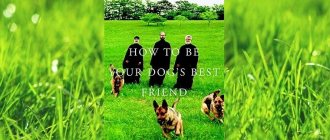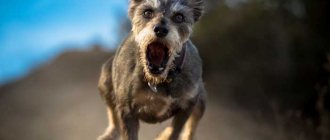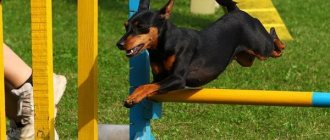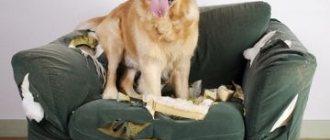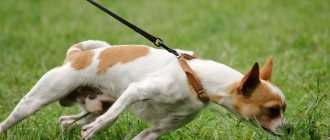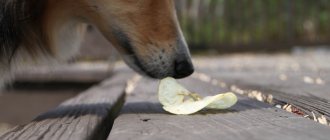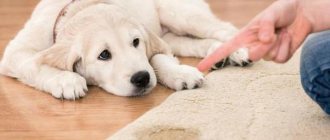Ban
A well-mannered pet always reacts clearly to the commands of its owner, who prohibit certain actions. Gradually, the dog learns what behavior is unacceptable and stops demonstrating it.
Usually it is enough for a person to say the commands “No”, “Fu”, “Come to me” for the animal to abandon its intention to jump on a car rushing past.
But unintelligent puppies and undisciplined adult dogs often do not respond to prohibitions, putting their lives in danger. In this case, more serious measures must be taken.
Preventing the situation
Typically, chasing moving objects is typical for dogs that lead a sedentary life. Therefore, to prevent such a situation, you need to walk your pet as often as possible. Such animals need a lot of physical activity and active games. With an active lifestyle, the dog does not have the energy to chase moving objects.
Until your pet has developed the necessary skills, precautions must be taken. The dog should only be walked near the roadway on a leash.
The reason for this behavior may also be the animal being alone for a long time. Therefore, your pet needs to be walked more often on sites with other dogs. It has been established that the tendency to chase cars is more often observed in dogs with low socialization. It is also often difficult to wean a dog from peeing on the bed; how to do this can be found in this article: https://fb.ru/article/416323/kak-otuchit-sobaku-pisat-na-krovat-osnovnyie-rekomendatsii.
Control
A pet whose behavior needs to be corrected should be kept on a leash in potentially dangerous places. In this case, a dog that decides to lunge at a passing car can be restrained in time.
The owner needs to use a short leash in order to react in time. When pronouncing a prohibiting command, you should fix the dog in place.
Experts do not recommend sharply tugging or pulling on the leash. It is enough to simply limit your pet’s physical activity.
Why do dogs attack cars and cyclists?
Most often, stray dogs bark at passing cars and cyclists. Among purebred pets, walked decorously on a leash, the percentage of such individuals is negligible. This makes it possible to consider such behavior as a sign of a dog’s aggressiveness, which is practically not found in domestic dogs due to their socialization and upbringing (and breed qualities that largely exclude aggression).
In addition, singling out cars and cyclists as objects of particular dislike for dogs is conditional. Many of them rush after skateboarders, rollerbladers, runners, and sometimes any moving object with the same zeal.
The theory that most likely explains this behavior is very simple - the hunting instinct “works” in dogs, which forces them to catch up with any fleeing objects.
By the way, this is why when meeting a stray dog that is showing signs of aggression, it is highly not recommended to turn your back on it and walk away, much less run away from it. The reaction is too predictable - it will catch up and rush.
But there are other reasons that try to explain this behavior of some dogs. Many of them have a right to exist:
- Dog ears are more sensitive than human ears. Therefore, the sound of an engine or the rustling of tires, almost imperceptible to the hearing of humans, can really cause irritation in dogs. It's entirely possible, but it doesn't explain why some dogs react aggressively to runners.
- Some zoological scientists believe that people sitting on or inside some kind of mechanism look especially threatening in the eyes of dogs. This makes them look bigger, which means they pose a greater danger.
A man on a bicycle looks big, which means, according to the dog, he poses a threat.
- According to another version, dogs do not like the sight of a spinning wheel, so they rush at it, for which they often pay with their lives. There are quite a lot of examples of this, so the version has a right to exist.
- By rushing at any moving objects, dogs simply guard their own territory and try to drive away strangers. This actually happens if the dog was fed in the parking lot or backyard of a store, but in this case he will bark harshly at all people passing by.
- It is very important for stray dogs to strengthen their position in the hierarchy of the pack; barking at large objects increases their status, for which reason they fearlessly rush at them.
In stray dogs living in a pack, barking at large objects increases their status
All versions sound plausible, but perhaps in each specific case one of them plays a larger role.
Negative reinforcement
With the help of a little dramatization, you can easily wean your pet from such a bad habit. For example, every time a dog barks at a car passing by, water pours out of the opening window or an unexpected loud noise is heard.
To ensure such conditions, it is enough to agree with a neighbor or acquaintance who will specially pass by while walking. One time is not enough to consolidate a negative impression, so several visits will be required.
Gradually, the animal will come to the conclusion that such behavior entails not the most pleasant consequences.
How to stop your dog from chasing cars, cyclists and runners
There is probably no one who has not at least once observed the following behavior in dogs:
- a dog chases cyclists;
- the dog runs after the car;
- the dog chases the runners.
Why is this happening? Why, sometimes with unostentatious frenzy, does a dog chase a runner, cyclist or car?
Here's what animal psychologists think about this.
In their opinion, dogs in a given conflict situation exhibit two types of behavior:
- aggressive, then she is ready to attack and attack;
- retreating, which indicates her fear of a potential enemy.
Many, most likely, noticed how dogs, at first trying to lunge towards the enemy, but seeing that he remained motionless, i.e. does not run away, frightened by her, they immediately retreat.
The fact is that this type of dog behavior is actually important from a survival point of view. The formula is simple - if you consider yourself strong and allow yourself to attack anyone you meet, then sooner or later you may meet someone who thinks the same, and he will be stronger than you. In such cases, those who show thoughtless aggression usually do not survive. This also happens to those who are too cowardly, who are afraid of anyone in advance. As a result, both of them receive neither food to maintain health nor females to continue the race.
Therefore, it is wiser, before you fight or run away, to try to find out how much your opponent is weaker or stronger than you. To do this, the dog uses a false (test) attack, during which it evaluates the enemy’s reaction. If the enemy is cowardly, turns around and begins to run away, then the dog begins an exciting chase, which carries him away.
When the owner takes the puppy outside for a walk for the first time, everything around him seems dangerous to the puppy. People running past, bicycles, motorcycles or cars driving towards him can cause him particular danger.
Feeling frightened, the puppy tries to cling to the owner’s legs, barks in fear and suddenly sees that the “danger”, frightened by his barking, moves away from him.
It seems to the puppy that the enemy has been defeated, and it is difficult for him to resist running a little more after the defeated enemy, which is what the puppy is trying to do.
Moreover, a few similar coincidences are enough for the puppy to decide that the person, bicycle or car ran away because he growled and barked menacingly at them. As a result, this negative skill in the puppy’s behavior began to be consolidated.
Some dog owners do not pay attention to this in time, which leads to the fact that this behavior becomes more and more entrenched, as a result of which it will be increasingly difficult to fight it in the future. This, in turn, poses a danger not only to others, but also to the dog itself, since while trying to chase a cyclist, motorcyclist or car on a busy highway, the dog can get hit by the wheels of passing cars. As a result, her health will be harmed or she will die.
To avoid such unwanted situations when a dog chases a cyclist, a dog runs after a car, or chases a person jogging, you need to properly stop these unwanted actions.
First of all, you need to introduce the puppy to everything that can cause him fear, gradually, calming him down and making him understand that a car, bicycle or person running past is not dangerous for him. Under no circumstances should a puppy be punished for showing fear. However, there is no need to forcibly drag a reluctant puppy to the object that is the source of this fear. Of course, a puppy with a good nervous system may be able to withstand it, but one whose nervous system is not yet strong enough will be even more frightened.
If suddenly an emboldened puppy tries to give chase, it is necessary to immediately stop him and not give him the opportunity to perform an undesirable action. In this case, correcting the puppy’s behavior in relation to objects moving away from him, suppressing attempts to pursue them without the owner’s command, must comply with the general rule of raising a dog: what is allowed is reinforced.
What to do if, for some reason, it was not possible to stop the dog from chasing cars, cyclists or running people in a timely manner, and the dog has already “got into a rage”, enjoying such a chase? There is only one way out: you will have to use a noose, a strict or electric collar, and in especially difficult cases, a whip (which is still undesirable). In any case, it is necessary to create a rule in which an undesirable act on the part of the dog would be followed by immediate punishment. For example, when a dog tries to rush after a car passing by, sometimes it is enough to sharply pull the leash and give the prohibiting command “No!” for the dog to stop carrying out its intentions.
After the dog has complied with the command and refused the unwanted action, it is necessary to stop the above negative reinforcement (punishment) and use positive reinforcement - give the dog a treat, pet it and play with it.
When punishing a dog for unwanted behavior, you do not need to be particularly cruel to it. You should always remember that often a dog chasing a car, cyclist or runner is not a clearly expressed manifestation of aggression on its part, but only a form of playing “catch up”.
In addition to practicing stopping commands during walks, you need to try to show more attention to the dog, distracting it in time from objects moving past and switching its attention to something else, more interesting.
If you do this with your dog constantly, over time this unwanted behavior will disappear, and the dog will stop chasing sources of non-existent danger.
Source: V. Gritsenko. Training for beginners. Veche, 2006.
By the way, you can download this and other books about dog breeds, their maintenance and training for free from the library of our website.
Red herring
It’s worth trying to simply switch your pet’s attention to something else. Often dogs react to cars solely out of excitement, feeling the need to chase an elusive object.
When you see an approaching car, you need to immediately switch your pet’s attention to a ball or stick, throwing it in the opposite direction from the car.
Why do dogs run after cars and attack them?
There are two main reasons why dogs run after cars and rush at them - the hunting instinct and curiosity. These are the factors that underlie your pet's unsafe behavior.
A dog with well-developed hunting instincts perceives a moving vehicle as a large living object. Assuming there is danger in it, the dog chases the car, barks at it and even throws itself under the wheels. As a rule, a machine that has invaded the animal’s territory is subject to such an attack.
Curiosity is another reason why dogs attack cars. Young animals want to take a closer look at moving parts (car rims or spinning bicycle wheels) and begin to chase the vehicle.
There are situations when a dog that has lived for a long time in a village or country house, after moving to the city, begins to attack cars. This phenomenon is associated with a reaction to stimuli. Pets can acquire the habit of chasing cars and barking at them both as a puppy and as an adult. Such unsafe behavior must be corrected at the first sign, without excluding the help of an experienced dog handler.

